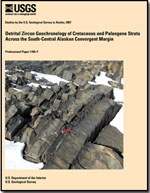Detrital Zircon Geochronology of Cretaceous and Paleogene Strata Across the South-Central Alaskan Convergent Margin
Links
- More information: USGS Index Page (html)
- NGMDB Index Page: National Geologic Map Database Index Page (html)
- Download citation as: RIS | Dublin Core
Abstract
Ages of detrital zircons are reported from ten samples of Lower Cretaceous to Paleogene metasandstones and sandstones from the Chugach Mountains, Talkeetna Mountains, and western Alaska Range of south-central Alaska. Zircon ages are also reported from three igneous clasts from two conglomerates. The results bear on the regional geology, stratigraphy, tectonics, and mineral resource potential of the southern Alaska convergent margin. Chugach Mountains - The first detrital zircon data are reported here from the two main components of the Chugach accretionary complex - the inboard McHugh Complex and the outboard Valdez Group. Detrital zircons from sandstone and two conglomerate clasts of diorite were dated from the McHugh Complex near Anchorage. This now stands as the youngest known part of the McHugh Complex, with an inferred Turonian (Late Cretaceous) depositional age no older than 91-93 Ma. The zircon population has probability density peaks at 93 and 104 Ma and a smattering of Early Cretaceous and Jurassic grains, with nothing older than 191 Ma. The two diorite clasts yielded Jurassic U-Pb zircon ages of 179 and 181 Ma. Together, these findings suggest a Mesozoic arc as primary zircon source, the closest and most likely candidate being the Wrangellia composite terrane. The detrital zircon sample from the Valdez Group contains zircons as young as 69 and 77 Ma, consistent with the previously assigned Maastrichtian to Campanian (Late Cretaceous) depositional age. The zircon population has peaks at 78, 91, 148, and 163 Ma, minor peaks at 129, 177, 330, and 352 Ma, and no concordant zircons older than Devonian. A granite clast from a Valdez Group conglomerate yielded a Triassic U-Pb zircon age of 221 Ma. Like the McHugh Complex, the Valdez Group appears to have been derived almost entirely from Mesozoic arc sources, but a few Precambrian zircons are also present. Talkeetna Mountains - Detrital zircons ages were obtained from southernmost metasedimentary rocks of the Talkeetna Mountains (schist of Hatcher Pass) and, immediately to the south, the northernmost sedimentary sequence of the Matanuska forearc basin (Arkose Ridge Formation). Detrital zircons from the Paleogene Arkose Ridge Formation are as young as 61 and 70 Ma; the population is dominated by a single Late Cretaceous peak at 76 Ma; the oldest zircon is 181 Ma. Sedimentological evidence clearly shows that the conglomeratic Arkose Ridge Formation was derived from the Talkeetna Mountains; our detrital zircon data support this inference. Zircons dated at ca. 90 Ma in the Arkose Ridge sample suggest that buried or unmapped plutons of this age may exist in the Talkeetnas. This is a particularly interesting age as it corresponds to the age of the supergiant Pebble gold-molybdenum-copper porphyry prospect near Iliamna and suggests a new area of prospectivity for Pebble-type deposits. The schist of Hatcher Pass, which was previously assigned a Jurassic depositional age, yielded surprisingly young Late Cretaceous detrital zircons, the youngest at 75 Ma. The probability density curve has four Cretaceous peaks from 76 to 102 Ma, a pair of Late Jurassic peaks at 155 and 166 Ma, three Early Jurassic to Late Triassic peaks at 186, 197, and 213 Ma, minor Carboniferous peaks at 303 and 346 Ma, and a minor Paleoproterozoic peak at 1828 Ma. The schist of Hatcher Pass was largely derived from Mesozoic arc sources, most likely the Wrangellia composite terrane, with some contribution from one or more older, inboard sources, probably including the Yukon-Tanana terrane. We postulate that the schist of Hatcher Pass represents metamorphosed rocks of the Valdez Group that were subducted and then exhumed along the Chugach terrane's 'backstop' during Paleogene transtension. Western Alaska Range - Six detrital zircon samples were collected from a little studied belt of turbidites in Tyonek quadrangle on strike with the Kahiltna assemblage of the central Alaska Range.
Study Area
| Publication type | Report |
|---|---|
| Publication Subtype | USGS Numbered Series |
| Title | Detrital zircon geochronology of Cretaceous and Paleogene strata across the south-central Alaskan convergent margin |
| Series title | Professional Paper |
| Series number | 1760 |
| Chapter | F |
| DOI | 10.3133/pp1760F |
| Year Published | 2009 |
| Language | English |
| Publisher | U.S. Geological Survey |
| Contributing office(s) | Alaska Science Center |
| Description | iii, 36 p. |
| Larger Work Type | Report |
| Larger Work Subtype | USGS Numbered Series |
| Larger Work Title | Studies by the U.S. Geological Survey in Alaska, 2007 (Professional Paper 1760) |
| Country | United States |
| State | Alaska |
| Online Only (Y/N) | Y |


